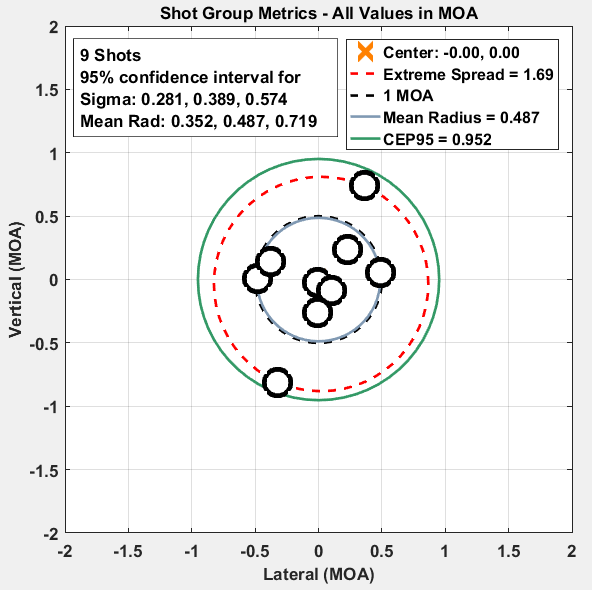Took 4 rifles to the range on Friday:
18″ 308 Fulcrum
18″ 223 Fulcrum
18″ 6.8 Recon
22″ 6.8 Heavy
Except for the 223, all shooting was with hand loads. Today’s post relays the results of 20 rounds of 308. The rifle was wearing a Vortex PST, decent but nothing fancy.
18″ 308 Fulcrum Results
My version of the 168 SMK FGMM
Load 1:
168 SMK over 42 grains of H4895
Federal cases, CCI large rifle primers
OAL 2.80″
MV 2577fps
Result: 10 shot group at 100 yards
Sigma = 0.249MOA (0.183 to 0.358 – 95% confidence)
Extreme Spread = 0.82 MOA
P1-0.5 = 91.8% (72 to 99% – 95% confidence)
P1-1.0 = 100% (99 to 100% – 95% confidence)
Pretty good. Indicates high probability that 7/10 shots are expected to be within 0.5MOA of true point of aim, and 10/10 shots should be within 1.0MOA of target. For an auto loader this is great.

Load 2:
168 SMK over 43 grains of H4895
Federal cases, CCI large rifle primers
OAL 2.80″
MV 2611fps
Note: First shot was 2″ below the center of the rest of the group. I’m calling this an outlier, but I don’t like it.
Result: 9 shot group at 100 yards
Sigma = 0.389MOA (0.281 to 0.547 – 95% confidence)
Extreme Spread = 1.69 MOA
P1-0.5 = 66.9% (35.2 to 86% – 95% confidence)
P1-1.0 = 97.7% (79.5 to 100% – 95% confidence)
Not as good as the last group, and my shooting ability is an uncertain factor. Still, this data indicates high probability that 3.5/10 shots are expected to be within 0.5MOA of true point of aim, and 8/10 shots should be within 1.0MOA of target. So the question is: did my shooting fall apart and produce this less precise group, did the additional 1 grain of gunpowder cause the degradation, some combination of the two, or something else?

For fun we can combine the two groups by overlaying at the “center of mass” of each group

There is clearly a cluster in the middle and then two outliers. I’ll never know the cause but this is interesting. To get more insight, separating the groups by coloring them differently shows the contribution to the blob above from each (ignore the numbers, they’re for a single group):

The 17 rounds clustered in the middle imply something… the rifle is clearly capable of excellent accuracy for an auto-loading weapon. Did those two shots come from bad shooting? Bad loading? Fatigue? Are they truly representative of the weapon itself?
Possible I wasn’t as careful with the second batch of 10 rounds as I was with the first while charging the cases or seating the bullets. Or I was tired as this was later in the day after shooting the other rifles. And what was with that shot that was 2″ low? Clearly, more range time is warranted.
I’ll get to those other rifles in the next post.




